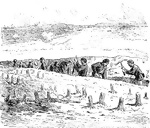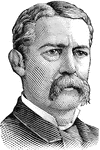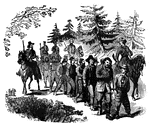
General Daniel Tyler
"General Tyler, born in Brooklyn, Windham County, Conn., January 7th, 1797, died in New York city, November…

Union Uniforms
This sketch depicts Americans exchanging rags for U.S. Army clothing or uniforms to fight for the Union…

USS Carondelet
The USS Carondelet was a City class ironclad gunboat constructed for the Union Navy by James…

Vermont Regiment
"Encampment of the First Vermont Regiment, Colonel Phelps, at Newport News, Va."— Frank Leslie, 1896

Advance to Vicksburg
"Skirmishing in the woods, on the advance to Vicksburg. Our artist presents a most beautiful scene,…

Siege of Vicksburg
"Siege of Vicksburg- the fight in the crater of Fort Hill after the explosion, June 27th, 1863. Our…

Siege of Vicksburg
"Siege of Vicksburg. Life in the trenches- bivouac of Leggett's Brigade- McPherson's Corps at the White…

Siege of Vicksburg
"Siege of Vicksburg-the Twenty-third Indiana and Forty-fifth Illinois Regiments, Leggett's Brigade,…
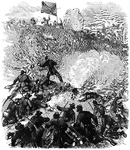
Siege of Vicksburg
"Siege of Vicksburg- General Sherman's fight with hand grenades, June 13th, 1863. On the 13th of June…

Siege of Vicksburg
"The siege of Vicksburg. General Grant meeting the Confederate General Pemberton at the Stone House,…

War in Virginia
"The War in Virginia. Capture of three Confederate guns, near Culpepper, by General Custer's cavalry…

War in Virginia
"The war in Virginia- officers and men of Meade's army discovering unburied Federal dead on the old…
War in Virginia
"The war in Virginia. Battery on the left of the enemy's line, in front of Petersburg, captured by the…

War in Virginia
"The war in Virginia- Confederate signal station near Beverley Ford."— Frank Leslie, 1896

War in Virginia
"The war in Virginia. General Butler's lines south of the James, Va., with troops in position near the…

War in Virginia
"The war in Virginia--railroad bridge over the Rappahannock, at Rappahannock Station."— Frank Leslie,…
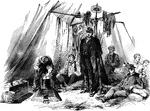
Thirteenth Illinois Volunteers
"Scene in camp life- company mess of the Thirteenth Illinois Volunteers in their camp before Corinth,…

Fort Wagner
"Siege of Charleston, S. C.- Federal sharpshooters approaching Fort Wagner before the avacuation."—…

Fort Walker
"View from the interior of Fort Walker, Hilton Head, S. C. looking inland, showing the defenses from…

Fort Walker
"Landing of United States troops at Fort Walker, after the bombardment, November 7th, 1861. In order…
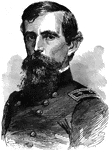
Lewis Wallace
"General Lewis Wallace, born in Brookville, Frankly County, Ind., April 10th, 1827, served in the Mexican…
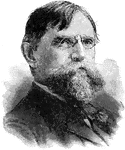
Lewis Wallace
Lewis "Lew" Wallace (1827 - 1905) was a lawyer, governor, and Union general in the Civil War. He is…

War Dance
"Camp life in the West. During one of the pauses in the active part of the Missouri campaign our special…

War Token, 1863
War token with head with winged cap obverse and eagle with shield reverse. These little mementoes of…

War Token, 1863
War token with femal head and "FOR PUBLIC ACCOMODATION" obverse and eagle reverse. These little mementoes…

War Token, 1863
War token with male head with Phrygian (liberty) cap obverse and "OUR LITTLE MONITOR" reverse. These…

War Token, 1863
War token with profile of Washington looking right obverse and cannon and "PEACE MAKER" reverse. These…

War Token, 1863
War token buiders square and compass obverse and shield and "UNITED STATES MEDAL" reverse. These little…

War Token, 1863
War token with Washington facing right obverse and "THE FLAG OF OUR UNION" reverse. These little mementoes…

War Token, 1863
War token with crossed flags obverse and crossed cannon reverse. These little mementoes of the War of…

War Token, 1865
War token with union shield and "ONE COUNTRY" obverse and snake and "BEWARE" reverse. These little mementoes…

War Token, Civil War Period
War token with walking figure and "KNICKERBOCKER CURRENCY" obverse and shield and "UNION" reverse. These…

War Token, Civil War Period
War token with Sigel on hourseback and "HERO OF PEO RIDGE" obverse and shield and "OUR COUNTRY" reverse.…

Masquerade of War
"The Masquerade of War. Ingenious method of disguising the masts and hulls of Commodore Porter's morter…
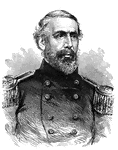
General J. H. Hobart Ward
"General Ward, born in New York city, June 17th, 1823, was educated at Trinity Collegiate School; enlisted…
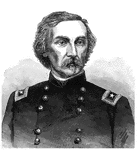
General Gouverneur K. Warren
"General Warren, born in Cold Spring, N. Y., January 8th, 1830, died in Newport, R. I., August 8th,…

Warsow Sound
"Reconnoissance of Warsaw Sound, December 5th, 1861, by a detachment of gunboats under Captain Rodgers,…

Water Skin
"Water skin and mode of carrying. Hints to Soldiers in the camp and on campaign."— Frank Leslie, 1896

Waterhouse's Battery
"Waterhouse's Battery, Sherman's Corps, before Vicksburg. The interior view of Waterhouse's battery,…
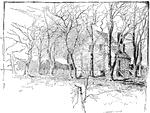
Watts' House at Battle of Gaines' Mill
Watts' House was an important house during the Battle of Gaines' Mill, also known as the First Battle…
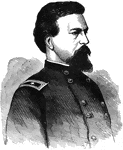
General Alexander S. Webb
"General Webb, born in New York city, February 15th, 1835, was graduated from the United States Military…

Weehawken
"The ironclad Weehawken returning to fire a parting shot at Fort Sumter, after the bombardment,…
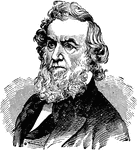
Gideon Welles
Gideon Welles (July 1, 1802 – February 11, 1878) was the United States Secretary of the Navy from…

Westfield
"Fire raft sent down from Fort Jackson to destroy the Federal fleet below the fort- the boats of the…

Wheelbarrow Race
"Soldiers aparticipating in a wheelbarrow race. Thanksgiving festivities at Fort Pulaski, Ga., Thursday,…
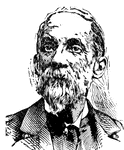
General Joseph Wheeler
(1836-1936) American Major-General active in Civil War and the Spanish-American War. Held a seat in…
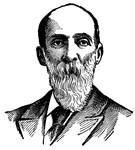
General Joseph Wheeler
(1836-1936) American Major-General active in Civil War and the Spanish-American War. Held a seat in…

White House Landing
"White House Landing, Pamunkey River, Va., the Grand Depot of the Commissariat and Ordinance Department…

Burning of the White House
"Burning of the White House- the Federal troops, by command of General McClellan, abandoning their position…
Burning of the White House
"Burning of the White House- the Federal troops, by command of General McClellan, abandoning their position…
